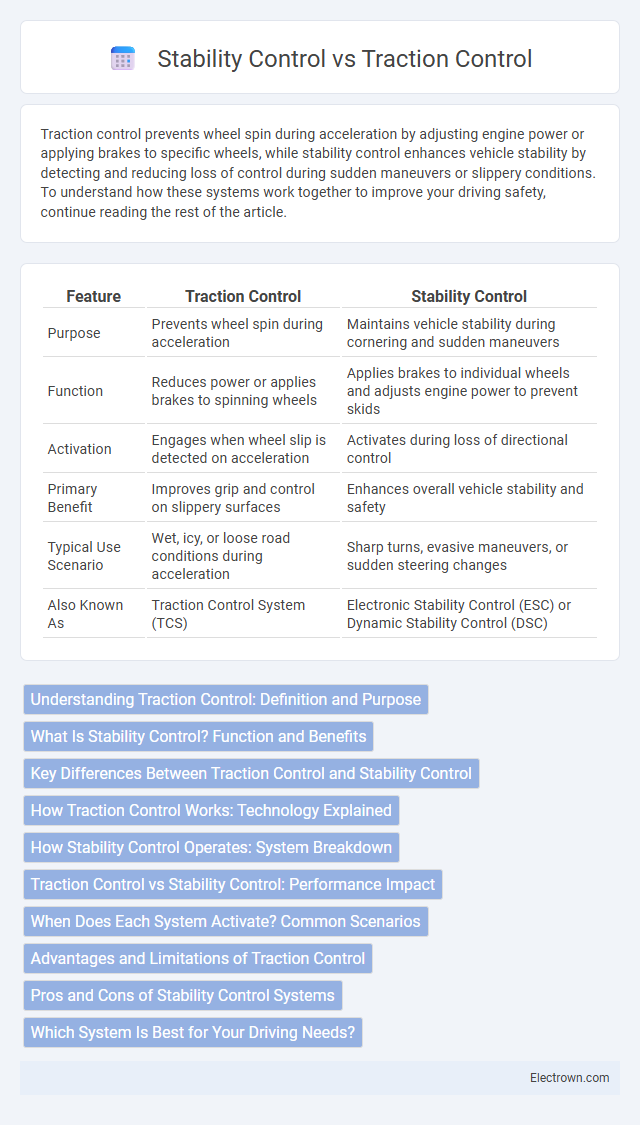Traction control prevents wheel spin during acceleration by adjusting engine power or applying brakes to specific wheels, while stability control enhances vehicle stability by detecting and reducing loss of control during sudden maneuvers or slippery conditions. To understand how these systems work together to improve your driving safety, continue reading the rest of the article.
Table of Comparison
| Feature | Traction Control | Stability Control |
|---|---|---|
| Purpose | Prevents wheel spin during acceleration | Maintains vehicle stability during cornering and sudden maneuvers |
| Function | Reduces power or applies brakes to spinning wheels | Applies brakes to individual wheels and adjusts engine power to prevent skids |
| Activation | Engages when wheel slip is detected on acceleration | Activates during loss of directional control |
| Primary Benefit | Improves grip and control on slippery surfaces | Enhances overall vehicle stability and safety |
| Typical Use Scenario | Wet, icy, or loose road conditions during acceleration | Sharp turns, evasive maneuvers, or sudden steering changes |
| Also Known As | Traction Control System (TCS) | Electronic Stability Control (ESC) or Dynamic Stability Control (DSC) |
Understanding Traction Control: Definition and Purpose
Traction control is a vehicle safety feature designed to prevent wheel spin during acceleration by automatically adjusting engine power or applying brake force to specific wheels. Its primary purpose is to maintain optimal tire grip on slippery or uneven road surfaces, enhancing vehicle control and reducing the risk of skidding. Unlike stability control, which focuses on maintaining overall vehicle balance, traction control specifically addresses loss of traction in individual wheels.
What Is Stability Control? Function and Benefits
Stability control is an advanced safety system designed to prevent skidding and loss of vehicle control by automatically applying brakes to individual wheels and adjusting engine power. Its primary function is to help maintain your vehicle's intended direction during sharp turns or slippery road conditions, significantly reducing the risk of accidents. The benefits include enhanced driving confidence, improved handling in adverse weather, and increased overall road safety.
Key Differences Between Traction Control and Stability Control
Traction control primarily manages wheel spin during acceleration to maintain grip, while stability control focuses on preventing skidding and loss of control during cornering and sudden maneuvers. Traction control uses sensors to detect slip and selectively brakes individual wheels or reduces engine power, whereas stability control integrates steering angle, yaw rate, and lateral acceleration sensors for more comprehensive vehicle stability adjustments. The key difference lies in their functions: traction control enhances grip and acceleration performance, whereas stability control ensures overall vehicle control and safety.
How Traction Control Works: Technology Explained
Traction control works by monitoring wheel speed sensors to detect slip during acceleration and modulating engine power or applying individual brakes to maintain optimal grip. This system prevents wheel spin by adjusting torque delivery to the driven wheels, ensuring better traction on slippery surfaces. Advanced traction control integrates with electronic stability control systems to enhance overall vehicle handling and safety.
How Stability Control Operates: System Breakdown
Stability control operates by continuously monitoring vehicle dynamics through sensors measuring steering angle, wheel speed, yaw rate, and lateral acceleration to detect loss of control. The system intervenes by selectively applying brake force to individual wheels and adjusting engine power to stabilize the vehicle's trajectory. This intervention helps prevent skidding or spinouts by counteracting understeer or oversteer during critical maneuvers.
Traction Control vs Stability Control: Performance Impact
Traction control enhances your vehicle's performance by preventing wheel spin during acceleration, ensuring optimal grip on slippery surfaces. Stability control improves handling by automatically adjusting braking and engine power to maintain vehicle direction during sudden maneuvers or skids. Together, these systems deliver a safer and more confident driving experience by optimizing traction and stability in various conditions.
When Does Each System Activate? Common Scenarios
Traction control activates when wheel slip is detected during acceleration, commonly on slippery surfaces like wet roads or loose gravel to prevent wheel spin. Stability control intervenes when the vehicle's sensors detect a loss of directional control or skidding, typically during sharp turns or sudden maneuvers to maintain vehicle stability. Both systems use braking and engine power adjustments, but traction control focuses on maintaining grip, while stability control manages overall vehicle balance.
Advantages and Limitations of Traction Control
Traction control enhances vehicle grip on slippery surfaces by preventing wheel spin, improving acceleration and safety during cornering or rapid acceleration. Its advantages include better control on uneven terrain and reduced risk of skidding, but it may limit engine power and can be less effective on high-traction surfaces or complex driving scenarios. Your driving experience benefits from improved stability, though reliance on traction control might reduce your ability to handle sudden maneuvers manually.
Pros and Cons of Stability Control Systems
Stability control systems enhance vehicle safety by automatically adjusting brakes and engine power to prevent skidding and loss of control, especially on slippery roads or during sudden maneuvers, making them essential for accident prevention. However, their reliance on sensors and electronic components can lead to increased repair costs and potential malfunctions. Your driving experience benefits from added confidence and control, though overreliance on stability control might reduce skill development in handling challenging conditions.
Which System Is Best for Your Driving Needs?
Traction control optimizes grip by preventing wheel spin during acceleration, making it ideal for slippery or uneven surfaces. Stability control enhances vehicle balance by correcting skids and maintaining directional control, crucial for sharp turns and emergency maneuvers. Choosing between the two depends on driving conditions: traction control suits low-traction environments, while stability control provides overall safety across diverse scenarios.
Traction control vs Stability control Infographic

 electrown.com
electrown.com